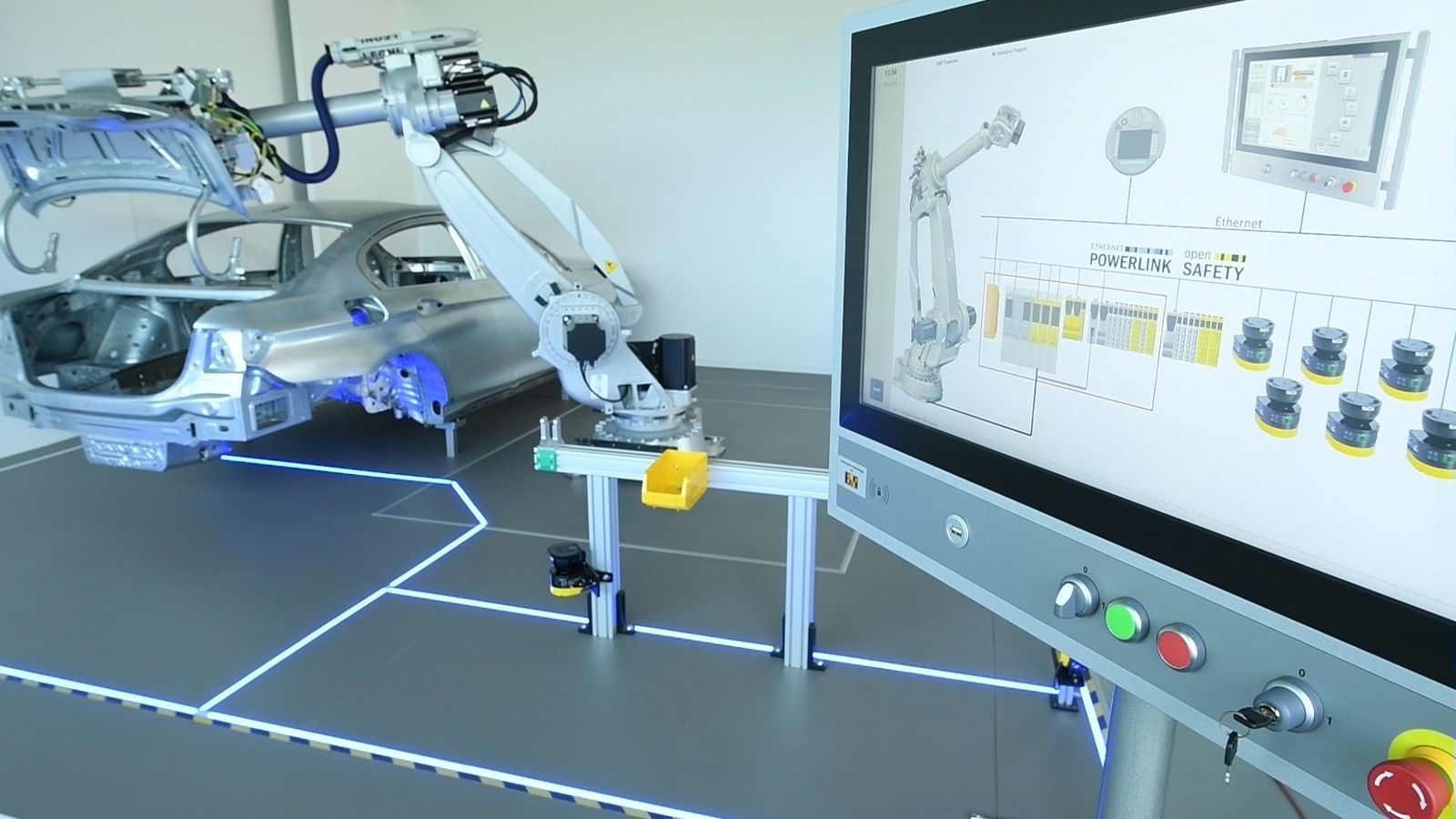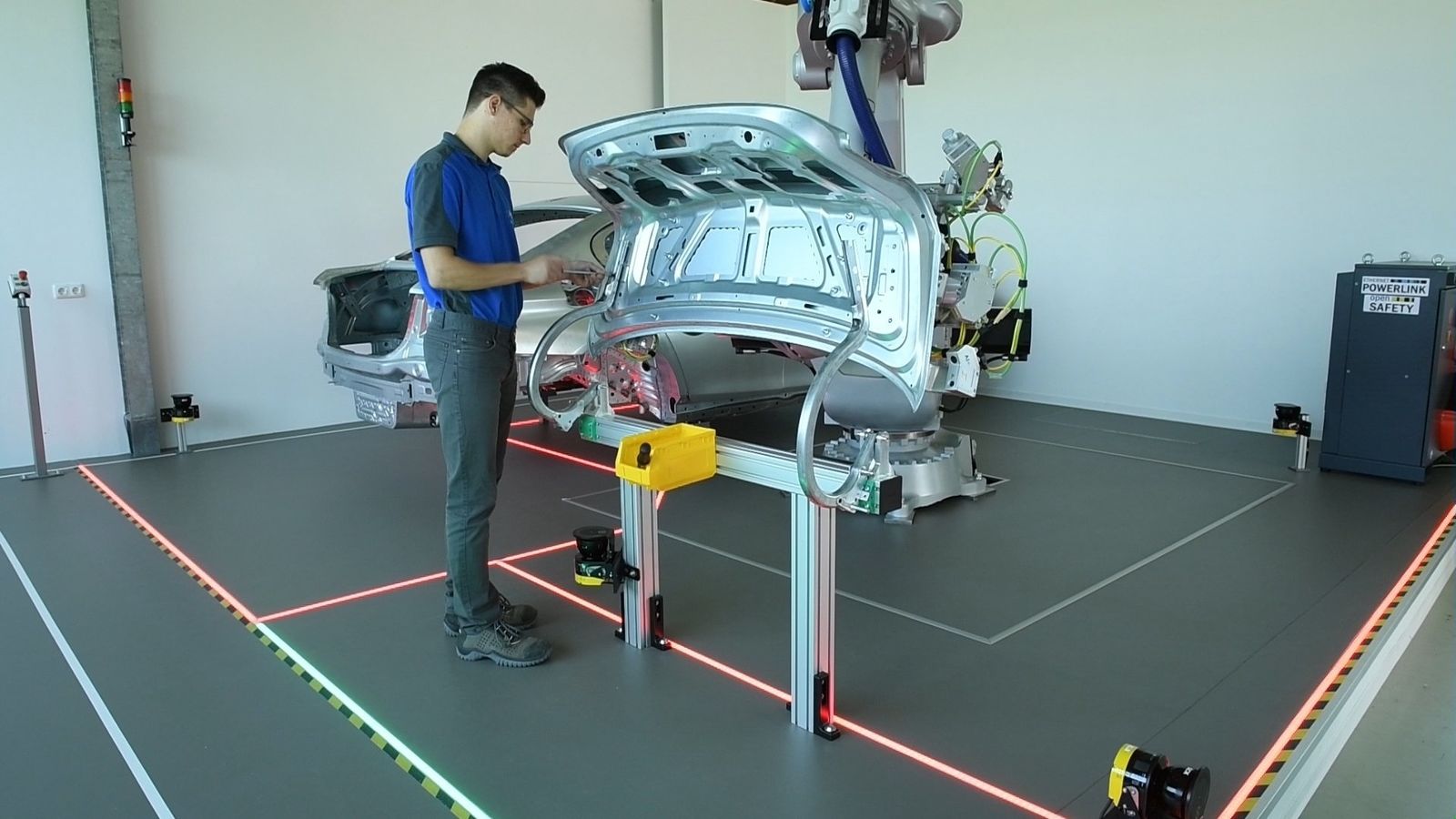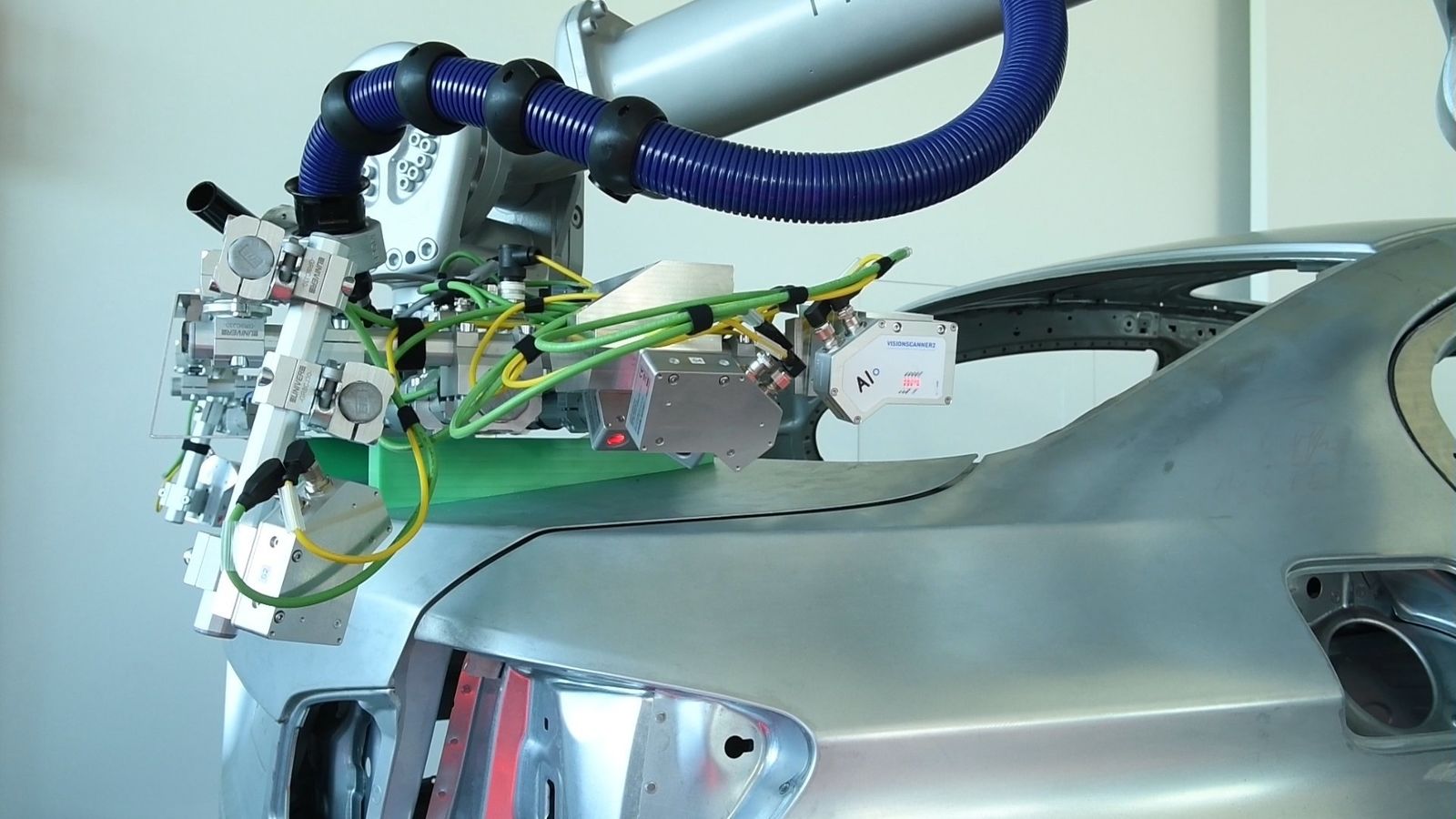It's one of mankind's age-old dreams: humans and robots working shoulder-to-shoulder in perfect harmony. Humans' fine motor skills and ability to learn from experience give them an edge in terms of flexibility, whereas robots are able to handle tedious and strenuous tasks with unfailing quality and repeatability. Combining the best of both worlds can help optimize existing processes or give rise to entirely new ones. In its demo cell showing the assembly of a car tailgate, EngRoTec proves that, even under the formidable conditions of heavy-duty robotics, true human-robot collaboration (HRC) is far more than just wishful thinking.

The scene is impressive to behold. A 2.7-meter-long robot with a maximum capacity of 220 kilograms transports the entire tailgate of a car to a mounting fixture, as EngRoTec engineer Sebastian Filk watches from behind a strip of red LEDs that marks the boundaries of his workstation. If he were to step over the boundary, the robot would stop within milliseconds or continue working at a sufficiently reduced speed to not endanger its human operator. As soon as Filk's "colleague of steel" comes to a stop, the lights change to green and he can safely enter. After fastening two hinges, he exits the area again and pushes a button on the next terminal to complete the work process. The robot then takes the pre-assembled tailgate to the body, positioning it with laser-guided precision. Once again, the green lights tell Filk the workpiece is in the right position and it is safe to enter. Even as he screws the tailgate onto the body, the controller is already busy sending quality data to the ERP system and requesting the next workpiece. In the future envisioned by Industry 4.0, this kind of intimate teamwork will soon become the norm.
Robots now service providers
Service robots for housework and healthcare have been making headlines for quite some time. Direct human-robot collaborations are well suited to assembly and handling of small parts. Robots provide welcome relief for workers who would otherwise have to perform tasks overhead or in ergonomically undesirable positions. (1) Applications of this type involve lightweight robotics where the moving masses are small and the drives operate at reduced speed and force so as not to pose a risk to humans.
Things are quite different in the world of heavy-duty robotics. There are numerous applications in automotive manufacturing where hundreds of robots working in safety cells weld together entire car bodies. "Most applications can now be automated under these conditions," explains Marc Burzlaff, managing director of EngRoTec. "In the future, the key will be bringing humans into the process and combining their intelligence with the advantages of robotics." The result will be considerably more effective and flexible production processes and improved working conditions for operators. "With Industry 4.0 and the advent of mass customization, these advantages will only gain in significance," says Burzlaff.

Heavy-duty robotics demand serious safety
With humans and robots working and moving in the same physical space, contact between them is inevitable – possibly even intentional. The high risk of injury makes ensuring operator safety a primary concern. Applicable guidelines for doing so can be found in the standards DIN EN ISO 10218 and ISO/TS 15066. (2) Required safety clearances for specific tasks can be derived, as well as maximum movement speeds and requirements for workspace monitoring. The demands on the safety technology used are correspondingly high.
Having executed numerous HRC projects in the automotive industry, Burzlaff knows that the response time of the entire safety chain can be a make-or-break factor in the success of an HRC application. "If you can get the safety response time under 350 to 400 milliseconds, you can reduce safety clearances by up to 50% compared to the current state of the art," he explains. This in turn reduces the overall equipment footprint. Workers benefit from shorter distances to travel and more ergonomically designed workstations.
Conventional MRC solutions are based on standard robots with their own control systems, separate cell control and safety technology. Decentralized management of the numerous safety parameters and communication between systems require an enormous amount of development work. "With that level of complexity, it's not possible to achieve response times under 500 milliseconds," says Burzlaff.
openROBOTICS makes it possible
In 2015, EngRoTec developed the AI robot control system that made robot-assisted and tolerance-optimized tailgate mounting possible. This field-proven and trade-association-approved application has now been further developed in a new HRC demo cell. "Being able to realize these scenarios for our customers in a cost-effective way was a primary focus of our work," says Burzlaff. "To make it possible, we had to re-evaluate our automation solution from the ground up."
After in-depth market research, the EngRoTec engineers decided on a Comau robot, augmented by B&R's freely configurable control technology. The result of this cooperation is called openROBOTICS and allows this type of robot to be tightly integrated into the overall system. "Comau dispensed with its own robot control, which significantly reduced the complexity of the automation technology. Furthermore, the B&R technology used for control, motion and safety technology and the SafeROBOTICS technology package not only dramatically reduced the engineering cost, but also the safety response time," says Tobias Daniel, head of sales and marketing for robotics at Comau.

B&R sets standards with SafeROBOTICS
These solutions really play to B&R's strengths as a system provider. Control, motion and integrated safety technology can be freely selected and configured. The performance of real-time Ethernet POWERLINK with openSAFETY and the ability to complete all engineering using B&R's Automation Studio won over EngRoTec's developers. B&R further supports their engineering work by providing an array of technology packages.
One such package, SafeROBOTICS, performs a variety of important functions that can be used to implement HRC applications for a wide range of different tasks. For example, multiple flanges, joints, monitoring and tool center points, as well as up to 20 cuboids or planes placed anywhere in the space can be simultaneously safety-monitored and reconfigured in real time. To make configuration easier, this data can be applied directly from a simulation tool.
SafeROBOTICS also includes safe motion control functions which monitor the movement of the robot's tool center point (TCP) and ensure safe positioning, speed and orientation of the robot. Without these functions, an HRC application would be difficult or impossible to implement.
With them, the response time of the safety application can be reduced dramatically. "In this application, we've achieved a safe 320-millisecond reaction from the time the laser scanner detects a workspace violation to the time the drives are safely shut down. That's a world record," notes Markus Sandhöfner, managing director of B&R Germany. The performance further benefited from the expertise of EngRoTec, who was able to eliminate the need for a lot of hardware and other equipment through intelligent, database-supported software and controller design.
Increasing productivity and reducing workload
Burzlaff sees customer benefits particularly in the reduced safety clearances and control cabinet footprint. The drastically reduced space requirements bring noticeable improvements for production line workers in terms of the distances they have to cover. In the case of the EngRoTec demo cell, this means 15 fewer square meters of floorspace, 40% less distance to travel and a cycle time reduction of 7%.
"If we do even more database-driven work and cut down on further hardware by using openSAFETY light curtains, we will be in a position to reduce response times by another 70 milliseconds. These are huge leaps forward for human-robot collaboration on the assembly line," states Burzlaff confidently. It is safe to say that further advancing this technology is a worthwhile pursuit.

Literature
(1) BGHM (2016) Trade Association for Wood and Metal, Fraunhofer IFF Magdeburg carries out research on behalf of the BGHM for man-robot collaboration in Industry 4.0: www.bghm.de/bghm/presseservice/pressemeldungen/detailseite/sichere-zusammenarbeit-von-mensch-und-roboter/ (viewed on 11/14/2016)
(2) Schenk (2012). Michael Schenk, Norbert Elkmann: Safe man-robot interaction, requirements, conditions, scenarios and proposed solutions. Demographic change - a challenge for the work and company organization of future series by the Academic Society for Work and Industrial Organization (HAB). Egon Müller (publisher)
 | Markus Sandhöfner General Manager, B&R Germany "The use of B&R technology – our flexible hardware and software components combined with extremely efficient integrated safety technology – will be pivotal in helping establish HRC technology in manufacturing." |
 | Marc Burzlaff Managing Director, EngRoTec-Solutions GmbH "In the future, the key will be bringing humans into the process and combining their intelligence with the advantages of robotics. With Industry 4.0 and the advent of mass customization, these advantages will only gain in significance." |